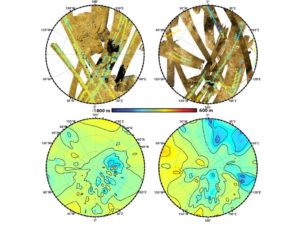
NASA’s Solstice Mission: First topographic images of Saturn’s Moon “Titan”
Titan, Saturn’s largest moon with a radius of about 2600 kilometers is bigger than Planet Mercury and is one of the most Earth-like and interesting “worlds” in the solar system. Titan is special as it’s the only moon in the solar system known to have clouds, surface liquids and a “mysterious” thick atmosphere. Titan’s atmosphere is mostly nitrogen, like Earth’s, but the difference – methane on Titan acts the way water vapor does on Earth, forming clouds and falling as rain and carving the surface with rivers. “Methane Rainfall”! Now that’s something. Scientists believe that the methane present in the lakes and rivers in Saturn’s Moon could offer answers about the origin of life.
All this makes this mission to the Saturn’s Moon, all the more AWESOME!
Using data from NASA’s Cassini mission, researchers have now created the first global topographic map of Titan. The significance of the map is self-evident considering that Titan is one of the most Earth-like “celestial object” in the solar system.

These polar maps show the first global, topographic mapping of Saturn’s moon, using data from NASA’s Cassini mission.
Image credit: NASA/JPL-Caltech/ASI/JHUAPL/Cornell/Weizmann
NASA adds
“The map team used a mathematical process called splining – effectively using smooth curved surfaces to “join” the areas between grids of existing topography profiles obtained by Cassini’s radar instrument. The estimations fit with current knowledge of the moon – that its polar regions are “lower” than areas around the equator, for example. But connecting those points allows scientists to add new layers to their studies of Titan’s surface, especially those modeling how and where Titan’s rivers flow, and the seasonal distribution of its methane rainfall.”
“Titan has so much interesting activity – like flowing liquids and moving sand dunes – but to understand these processes it’s useful to know how the terrain slopes,” Ralph Lorenz, a member of the Cassini radar team based at the Johns Hopkins University Applied Physics Laboratory, Laurel, Md., who led the map-design team. “It’s especially helpful to those studying hydrology and modeling Titan’s climate and weather, who need to know whether there is high ground or low ground driving their models.”
Exciting times indeed!
To know more about Moon of Saturn. Visit NASA’s page
Did you like this post? Read more and subscribe to our monthly newsletter!







